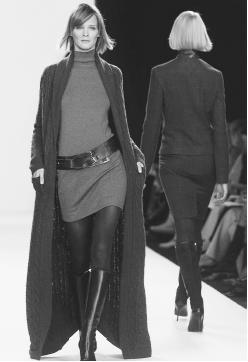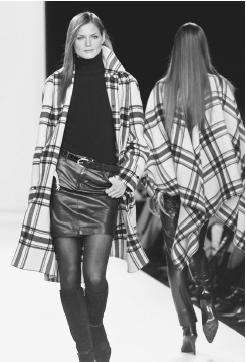Ralph Lauren - Fashion Designer Encyclopedia
American designer
Born: Ralph Lifschitz, Bronx, New York, 14 October 1939. Education: Studied business science, City College of New York, late 1950s. Military Service: Served in the U.S. Army, 1962-64. Family: Married Ricky Low-Beer, circa 1964; children: Andrew, David, Dylan. Career: Part-time sales assistant, Alexanders Stores, New York, 1956-57; assistant menswear buyer, Allied Stores, New York, 1958-61; salesperson, Bloomingdale's and Brooks Brothers, New

Publications
On LAUREN:
Books
Morris, Bernadine, and Barbara Walz, The Fashion Makers, New York, 1978.
Diamondstein, Barbaralee, Fashion: The Inside Story, New York, 1985.
Milbank, Caroline Rennolds, Couture: The Great Designers, New York, 1985.
Perschetz, Lois, ed., W, The Designing Life, New York, 1987.
Coleridge, Nicholas, The Fashion Conspiracy, London, 1988.
Trachtenberg, Jeffrey, Ralph Lauren: The man Behind the Mystique, Boston, 1988.
Milbank, Caroline Rennolds, New York Fashion: The Evolution of American Style, New York, 1989.
Canaedo, Anne, Ralph Lauren: Master of Fashion, Ada, Oklahoma, 1992.
Stegemeyer, Anne, Who's Who in Fashion, Third Edition, New York, 1996.

Le Dortz, Laurent, and Muriel Lartigue, Profil et dynamique du groupe Polo Ralph Lauren, Paris, 1999.
Le Dortz, Laurent, and Béatrice Debosscher, Stratégies des leaders américains de la mode: Calvin Klein, Donna Karan, Liz Clairborne, Polo Ralph Lauren, et Tommy Hilfiger, Paris, 2000.
Articles
Wohlfert, Lee, "What Do Woody, Bob, and Diane Have in Common? Money, Yes, But Designer Ralph Lauren Too," in People, 6 February 1978.
Ling, F., "Ralph Lauren's Polo Game," in Forbes, 26 June 1978.
"Profile of a Designer: Ralph Lauren," in the Sunday Times (London), 13 September 1981.
Langway, L., and L. R. Prout, "Lauren's Frontier Chic," in Newsweek, 21 September 1981.
Ettorre, Barbara, "Give Ralph Lauren All the Jets He Wants," in Forbes, 28 February 1983.
"Beyond the Name Game: New Design World from Halston and Ralph Lauren," in Vogue, September 1983.
Feretti, Fred, "The Business of Being Ralph Lauren," in the New York Times Magazine, 18 September 1983.
Trachtenberg, Jeffrey A., "You Are What You Wear," in Forbes, 21April 1986.
Cocks, Jay, "Born and Worn in the U.S.A.," in Time, 16 June 1986.
Infantino, Vivian, "Interview: Ralph Lauren," in Footwear News (New York), July 1986.
Koepp, Stephen, "Selling a Dream of Elegance and the Good Life," in Time, 1 September 1986.
Skenazy, Lenore, "Lauren Gets Honorable Mansion," in Advertising Age, 20 October 1986.
Tornabene, Lyn, "The World According to Ralph Lauren," in Cosmopolitan, February 1987.
Brubach, Holly, "Ralph Lauren's Achievement," in Atlantic Monthly, August 1987.
"Ralph Lauren: The Dream Maker," in U.S. News & World Report, 8February 1988.
Aronson, Steven M. L., "High Style in Jamaica," in House & Garden, October 1988.
Dowling, Claudia Glenn, "Ralph Lauren," in Life, May 1989.
"A Big Time Safari for Ralph Lauren," in WWD, 27 October 1989.
Mower, Sarah, "The Unspeakable Chic of Summer," in the Independent (London), 19 April 1990.
Hume, Marion, "In the Swing," in the Sunday Times (London), 29April 1990.
Parola, Robert, "Polo/Ralph Lauren," in DNR, 17 October 1990.
——, "Polo/Ralph Lauren: At the Crossroads," in DNR, 29 October 1990.
Buck, Joan Juliet, "Everybody's All-American," in Vogue (New York), February 1991.
Spevack, Rachel, "Polo and Izod: Adding New Luster to Knit Logos," in DNR, 12 March 1991.
Born, Pete, "Polo Crest Takes Fashion Approach to Fragrance," in DNR, 26 July 1991.
Forbes, Malcolm S., Jr., "Dressing Us with His Dreams," in Forbes, 2September 1991.
Slonim, Jeffrey, "Ralph Lauren: October 14," in Interview (New York), October 1991.
Talley, Andre Leon, "Everybody's All-American," in Vogue, February 1992.
Born, Pete, "New Men's Lauren Fragrance to Debut," in DNR, 6March 1992.
Siroto, Janet, "Ralph Lauren—Looking Back," in Mademoiselle, May 1992.
Moin, David, "Ralph Lauren is Back at Saks in a Big Way," in WWD, 14 October 1992.
Donaton, Scott, and Pat Sloan, "Ralph Lauren Sets Magazine Test," in Advertising Age, 2 November 1992.
Gross, Michael, "The American Dream," in New York, 21 December 1992.
Goldman, Kevin, "More Made-in-the-USA Claims, Surprisingly, are Showing Up," in Wall Street Journal, 15 January 1993.
Gross, Michael, "Ralph's World," in New York, 20 September 1993.
Mower, Sarah, "Ralph Lauren's New World of Sport," in Harper's Bazaar, October 1993.
Rutberg, Sidney, "Goldman, Sachs Buys into Ralph," in WWD, 24August 1994.
Gill, Brendan, "Lauren's Home Movies," in the New Yorker, 7November 1994.
Schiro, Anne-Marie, "Ralph Lauren Does What He Does Best," in the New York Times, 6 April 1995.
Menkes, Suzy, "Lauren: An Oscar for Polish," in the International Herald Tribune, 9 April 1995.
"Einer fur alle: Ralph Lauren, der Lifestyle-Spezialist," in Vogue Manner (Munich), April 1995.
Malone, Maggie, and John Leland, "Of Walls and Wanting," in Newsweek, 8 January 1996.
Goldstein, Lauren, "Ralph Lauren, Prince Charles, and You!" in Fortune, 9 November 1998.
"Polo Ralph Lauren Gets License Agreement with Danskin," in United Press International, 2 February 1999.
Keith, Andrew, and Elaine Marshall, "Ralph's Rough Ride," in Time, 15 March 1999.
"Food is Fashion," in Restaurants & Institutions, 15 April 1999.
Furman, Phyllis, "Ralph Lauren Teams with NBC for E-Commerce Company," in the Daily News, 7 February 2000.
Baker, John F., "A Fashion Statement," in Publishers Weekly, 27March 2000.
Weldon, Kristi, "Polo Sprints into the 21st Century," in Apparel Industry Magazine, June 2000.
Rubenstein, Hal, "The Look of Ralph Lauren," in In Style, 1 September 2000.
Geller, Adam, "Luxury Retailer Closing Polo Stores," in AP Online, 5October 2000.
"Style Guides," in Forbes, 9 October 2000.
"Lauren Creates the Polo Line, October 18, 1969," in DISCovering U.S. History, available online at galenet.gale.com , 17 October 2000.
"Ralph Lauren," in DISCovering U.S. History, online at galenet.gale.com , 17 October 2000.
Deeny, Godfrey, "Ralph's Riders," in Fashion Wire Daily, online at fashionwindows.com , 14 February 2001.
Horyn, Cathy, "For Kors and Lauren, A Fondness for the Paddock," in the New York Times, 15 February 2001.
Limnander, Armand, "Fall 2001 Ready-to-Wear," online at Style.com , 17 February 2001.
Davis, Boyd, "Ralph Lauren," online at fashionwindows.com , 2 June 2001.
Redstone, Susan, "Menwear Spring 2001," in online at fashionwindows.com , 2 June 2001.
***
Style, as opposed to fashion, is the major imperative underlying Ralph Lauren's work. Initially a designer of the high-quality ties that started the Polo label, Lauren soon directed his talents to menswear. Inspired by such notable dressers as the Duke of Windsor, Cary Grant, and Fred Astaire, he began to produce classic lines derivative of the elegant man about town or the country squire of a bygone age. A love of the fashions of the F. Scott Fitzgerald era led him to introduce wide neckties and bold shirt patterns. In 1974 Lauren achieved world acclaim as the designer of the men's fashions in the film version of F. Scott Fitzgerald's novel The Great Gatsby.
When he turned to womenswear, Lauren applied the same qualities of timeless elegance to his designs. By using uniformly high-quality tweeds, tailoring down men's trousers and jackets, and producing shirts in finer cottons, Lauren created clothes for the active woman of the 1970s, as epitomized in the Annie Hall look. These classic, tailored garments have changed little since they were first introduced but continue to epitomize long-lasting quality and style.
Another side of Lauren is seen in his Roughwear clothing. Directly inspired by the tradition of America's past, Roughwear takes the form of long tweed or plain skirts combined with colorful, hand-knitted, Fair Isle or sampler sweaters, tartan scarves, trilby hats, and lumber-jack's wind cheaters and brushed cotton shirts. The origins are easy to trace, but the result is an updated, truly American style. Romantic touches of Edwardian and Victorian times occur in lace-trimmed jabots and large collars delicately held together with aging cameo brooches. Shades of the classic English riding costume appear in his tailored tweed jackets. Lauren's contribution to fashion can perhaps best be summed up on the names that he gave to his cosmetics introduced in 1981: Day, Night, and Active.
In the 1990s, Lauren continued to tune into contemporary life. The Double RL label featured new, high-quality clothes that looked old as a response to the craze for the vintage and second-hand. For increasingly fitness-conscious women, he produced informal clothes with a strong fashion input. To appeal to the youthful interests of younger customers, Polo Jeans launched a line of contemporary casualwear in 1996. Two years later, Lauren's trademark aesthetic sensibility and superior craftsmanship was applied to the Polo Sport RLX line of high-performance athletic apparel.
As the new millennium approached, the Ralph Lauren Company began moving from Ivy League to pop culture by acquiring Canadian-based Club Monaco, marketing contemporary apparel, home furnishings, accessories, and cosmetics for the hip, urban crowd. In 2000, Ralph Lauren Media launched the Polo.com website, offering "comprehensive online access to the Ralph Lauren American lifestyle with clothing, accessories, fragrances, vintage items, travel, style tips, multimedia information and entertainment, world-class customer service and more." With son David Lauren as creative director, Polo.com aimed to "spread the upper-crust Ralph Lauren image to a new generation of shoppers," wrote Phyllis Furman in a February 2000 article in the Daily News.
Still, Lauren's womenswear for fall 2001 came full circle, offering the classic styling of equestrian looks from the country estate such as hacking jackets, taupe and ebony pants with suede knee patches, sleek crocodile belts with thoroughbred buckles, and riding boots with oilcloth spats. For the menswear spring 2001 collection, the timeless Polo line was updated with slim polo shirts and lime green, Nantucket red, and hot orange fuchsia-front trousers. The more dressed up Purple Line offered suits with sculpted waists and soft natural shoulders, paired with striped ties, creating the classic Lauren look.
Lauren's skill and experience has enabled him to design for women and men, their children, and their homes. As a native New Yorker, Lauren has promoted a truly American casual style in his prairie look while developing classic, uncluttered lines that have brought him international fame. Along with colleagues Bill Blass, Geoffrey Beene, and six other designers, Lauren earned a white bronze and granite marker along the Fashion Walk of Fame in New York City. This worldwide notoriety will also be the subject of a new biography of Lauren, the story, according to a March 2000 article in Publishers Weekly, of "a poor Russian Jewish immigrant boy who began in Seventh Avenue fashion house stock rooms and became a billionaire."
For Ralph Lauren, fashion is something that lasts for more than one season. It is this timelessness, abetted by inspirations deep in the soil of America's past, that distinguishes his work and won him a Lifetime Achievement award from the Council of Fashion Designers of America in 1992.
—Hazel Clark;
updated by Jodi Essey-Stapleton